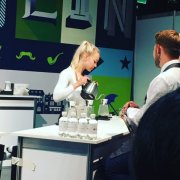Indonesia Mantenin rare hundred Flower Island Mantenin 18 eyes of Sumatra Mantenin

For professional baristas, please follow the coffee workshop (Wechat official account cafe_style)
Introduction:
Indonesian coffee is very diverse in quality, and most of them use the island's origin as its market name:
Such as Sumatra (Sumatra), Sulawesi (Sulawesi), Jawa (Java) or Timur (Timor).
The advantage of Indonesian coffee is that most coffee is characterized by strong, introverted flavor and lively moderate acidity.
Chinese people think highly of Indonesian Mandheling coffee, and it is one of the coffee products with the highest acceptance of single coffee.
Indonesia Mandheling was once praised as the best unique wet peeling coffee bean in the world. Manning is a trademark.
Nowadays, as long as the red cherry fruits of coffee harvested in Indonesia are processed by this unique wet peeling method, the raw coffee beans will be crowned
Manning coffee bean sales. Mantenin is from the Tapanuli area of northwest Sumatra by the Mandailing.
Grow coffee, because at the end of World War II, a Japanese soldier was introduced into the Japanese market.
Mandailing becomes Mandheling coffee.
Sumatra (Sumatra):
Coffee in Sumatra is very complex and elusive. Sumatra is large, but not all of it produces coffee.
Coffee trees are planted heavily in only the two northernmost provinces of the island's eight provinces-Aceh and Jiangsu:
Aceh coffee is mainly produced in the Gayo Mountain mountains around Lake Tawar (Lake Tawar).
Most of the farmers in this area are local Gayo People aborigines, while coffee in Jiangsu Province
Is the world's largest super crater lake-Lake Toba (Lake Toba) producing area and the southern side of Lindong (Lintong) producing area
For the main production areas, most of the local farmers are made up of Batak People aborigines.
Because many sharecropper producers and use their unique semi-washing treatment and lack of iron in the soil,
At the stage of fresh raw beans, coffee beans in this area have a special blue color.
Baihua Flores, when we first heard of this coffee, the first question was: "where is baihua Island?"
It was only after Google that Baihua Island was found to be a relatively large island in Indonesia's Sunda Islands. It was developed by the Portuguese in the 15th century.
Found it, because of the rich ecology, flowers blossom and named "Coba da Flores" hundred flowers island.
The local climate is humid. After preliminary washing, fermentation and exposure for one or two days, the moisture content of raw beans is still.
30% Murray 50%, that is, peel off the seed shell and then continue drying, in order to shorten the drying schedule of raw beans; about 2 days of drying
In time, the moisture content of raw coffee beans can be reduced to 13%. Indonesia is a unique method of semi-washing treatment, which is called by local people.
Giling Basah, also known as wet stripping (wet-hulled).
The most special thing about this coffee is its aroma! The moment you turn on the bean grinder, the surprisingly strong smell immediately fills the room.
You can't help but "notice" to share this wonderful moment with others. On the whole, this is a full-bodied, full-bodied, back-dried coffee.
Rich taste with low acidity sweet, if you do not like sour coffee, let a coffee to amaze your taste buds!
Important Notice :
前街咖啡 FrontStreet Coffee has moved to new addredd:
FrontStreet Coffee Address: 315,Donghua East Road,GuangZhou
Tel:020 38364473
- Prev

Manning single Coffee Story Manning English Manning Coffee from Lake Toba, Sumatra
For the exchange of professional baristas, please pay attention to the coffee workshop (Wechat official account cafe_style) single product series Mantenin Single OriginMandheling Indonesia has long been famous in Taiwan, he comes from the clay plateau on the edge of Tobahu in Sumatra, Indonesia, but Manning is not the name of the producing area or estate. His name is actually a beautiful misunderstanding. Japan during World War II
- Next

The distinguishing method and hand punching parameters of Mantenin from gold manning and gold tripod
For the exchange of professional baristas, please follow the coffee workshop (Wechat official account cafe_style) whether it is Mantenin or Gold Manning, all of which are made in Sumatra, Indonesia. Whether it is Lentong, Arche, Gayo, are collectively called Mantenin. The origin of Golden Manning comes from Japanese gluttons. Japanese gluttons have always loved Mantenin's strong and diverse
Related
- Detailed explanation of Jadeite planting Land in Panamanian Jadeite Manor introduction to the grading system of Jadeite competitive bidding, Red bid, Green bid and Rose Summer
- Story of Coffee planting in Brenka region of Costa Rica Stonehenge Manor anaerobic heavy honey treatment of flavor mouth
- What's on the barrel of Blue Mountain Coffee beans?
- Can American coffee also pull flowers? How to use hot American style to pull out a good-looking pattern?
- Can you make a cold extract with coffee beans? What is the right proportion for cold-extracted coffee formula?
- Indonesian PWN Gold Mandrine Coffee Origin Features Flavor How to Chong? Mandolin coffee is American.
- A brief introduction to the flavor characteristics of Brazilian yellow bourbon coffee beans
- What is the effect of different water quality on the flavor of cold-extracted coffee? What kind of water is best for brewing coffee?
- Why do you think of Rose Summer whenever you mention Panamanian coffee?
- Introduction to the characteristics of authentic blue mountain coffee bean producing areas? What is the CIB Coffee Authority in Jamaica?

